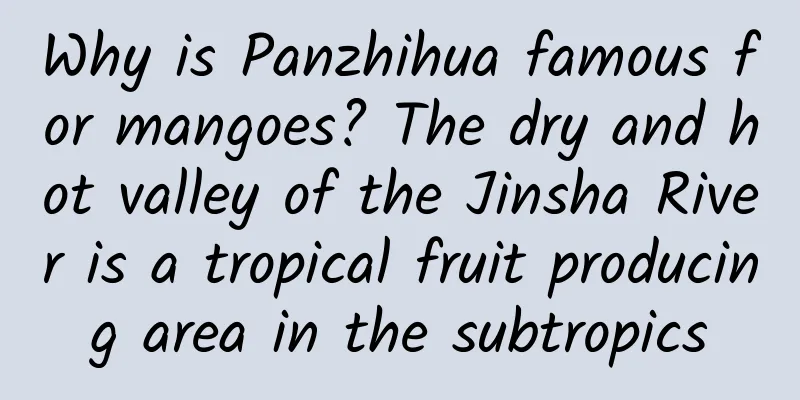Why is Panzhihua famous for mangoes? The dry and hot valley of the Jinsha River is a tropical fruit producing area in the subtropics

|
Although located in the subtropics, Panzhihua is rich in tropical fruits, thanks to the dry and hot valley of the Jinsha River. This somewhat "inharmonious" climate phenomenon has made this steel city also a well-known tropical fruit kingdom. 01Dry and hot valley, climate island Dry hot valley refers to the drier part of the valley bottom surrounded by relatively humid types. They are significantly different from the humid and semi-humid landscapes in the surrounding areas and appear inharmonious. my country's hot and dry river valleys are mainly distributed in parts of the Jinsha River, Nujiang River, Lancang River, Yuanjiang River, Yalong River, Minjiang River, Dadu River and Anning River and their tributaries in the Hengduan Mountain area, with a vertical amplitude of 200 to 1,000 meters, a total length of 4,105 kilometers and a total area of 11,230 square kilometers. ▲ Distribution map of dry and hot valleys. From "National Geographic China" October 2018 There are many explanations for the formation of dry hot valleys, among which the foehn effect is more easily accepted based on meteorological principles. The direction of the mountains in the Hengduan Mountains is generally perpendicular to the southwest monsoon or southeast monsoon. When the air flows through the mountains, it rises and cools along the windward slope, causing precipitation and reducing moisture. After passing the mountains, the air sinks along the leeward slope, and the temperature rises. The air temperature is much higher than that at the same height before passing the mountains, and the humidity is significantly reduced, causing drought in the valley area. The further inland you go, the more obvious this valley drought phenomenon is. ▲Schematic diagram of the formation of the foehn effect in the dry and hot valley. Photo/Geographic Calendar Among the three major types of arid areas uniformly classified globally, the dry and hot valleys are neither continental central deserts nor subtropical sparse grasslands, but rather local arid habitats. In local river valley areas with closed terrain, water is excessively lost due to the influence of dryness and heat, making it difficult for forest vegetation here to recover. Large areas of topsoil on the valley slopes are lost, exposing large areas of bare soil and bare rock. But this is not all bad. After studying the diversity of the flora in the Jinsha River Dry-Hot Valley, experts found that although the climate in the Jinsha River Dry-Hot Valley is dry and not conducive to the normal growth of plants, the abundant light and heat conditions in the valley provide conditions for the growth of many tropical and subtropical plants, and the special geographical location and terrain also create favorable conditions for the preservation of many species. ▲Distribution diagram of the main fruits in Panzhihua. Source: Authentic scenery Among them is the first-class protected plant of China, the Panzhihua Cycas, an ancient relic species unique to my country, which has pushed the northern boundary of the distribution of Cycas plants to 27°11′ north latitude. Tropical plants such as Delonix regia, Burmese laurel, and cactus can also be seen everywhere in the valley. Not only tropical plants, but also the river valleys below 1,400 meters above sea level have sufficient heat, abundant sunlight, large temperature differences between day and night, and distinct dry and rainy seasons, which are very suitable for the growth of tropical fruits such as mangoes and pomegranates. ▲Pomegranate picking. Photo by Li Yifan 02 Panzhihua, why does it produce tropical fruits? The average annual temperature along the Anning River and Jinsha River where Panzhihua is located is generally around 21°C, which is even comparable to Jinghong County (21.9°C) in Xishuangbanna Prefecture, which is located on the northern edge of the tropics; and the annual effective accumulated temperature ≥10°C is 6000-7700°C, which is also comparable to Jinghong's 7978.1°C. Jinghong's latitude is almost 4.5 degrees south of Panzhihua, and its altitude is only 550 meters, much lower than Panzhihua's 1190 meters. ▲Picking mangoes. Photo by Li Yifan This unique subtropical climate is conducive to the flowering and fruiting of mangoes. The dry and rainy winter is conducive to the differentiation of flower buds; the flowering period is sunny and dry without low temperatures, which is conducive to pollination and fruit setting; the fruit growing period has sufficient sunshine, abundant heat, and sufficient rainfall, and the water and heat are synchronized, so the fruit grows and develops well; the large temperature difference between day and night is conducive to the accumulation of nutrients and the conversion of sugars during the growth and development of the fruit. ▲Fruit market. Photo by Li Yifan We know that to make fruits sweet, two specific conditions must be met. First, the fruits must produce a large amount of organic matter to polymerize sugars; second, the acid in the fruits must be metabolized and decomposed. In other words, the fruits must have more sugar and less acid. The dry and hot valley of the Jinsha River is unique in that it has drought, little rain, long sunshine hours, sufficient heat, and a large temperature difference between day and night, which are very conducive to the accumulation of starch and the conversion of sugar in the fruits. The high temperature is also conducive to the metabolism and decomposition of the acid in the fruits, thereby reducing the acidity and increasing the sweetness. Because of this, the dry and hot valley of the Jinsha River, with Panzhihua City as its center, has become the only area in Sichuan Province where mangoes can be grown. It is also one of the few ecologically most suitable areas in my country for growing South Asian tropical fruits such as mangoes and longans. It is also the northernmost and highest altitude mango production base in China and even the world. In addition, rare tropical fruits such as wax apples, pitayas, pineapples, and sugar apples can all be produced in the valley. ▲Fruit market. Photo by Li Yifan Source: Xiake Geography |
<<: The bridge also has a "golden bell cover", so you don't have to worry about being hit anymore!
>>: First of its kind! my country's new breakthrough in quantum communication
Recommend
Momo information flow advertising display style and advertising case analysis!
Similar to social performance marketing platforms...
The folders on your phone are all in English, taking up memory but you dare not delete them. Here is how to delete junk files
Today I will teach you how to delete 4 English fo...
New brands use content IP as endorsement
Brands can find celebrities to endorse their prod...
When did the 2022 Changchun epidemic begin? When will it end and return to normal? Attached is the latest news!
Recently, new cases have appeared in Beijing, Cha...
The latest news on Beijing’s unblocking time in 2022: Has it been unblocked? Attached is the latest unblocking list!
The local epidemic that occurred in Beijing at th...
Li Chen's personal profile: How to determine whether a website has been punished by Baidu?
If the website traffic drops sharply during opera...
Activity fission growth formula
Different companies have different growth indicat...
Surprise! The "supermoon" will be here for the Mid-Autumn Festival. This year, you can "feast your eyes"
The bright moon rises over the sea, and the world...
Content Operations: To write a good copy, start by learning how to chat
Sincere emotions, clear views, fluent language an...
Pinduoduo: Building a growth model with the North Star indicator
The North Star refers to the absolute core indica...
Yutong Bus and Juefei Technology jointly launched autonomous driving technology for the first time in domestic passenger buses
Recently, Juefei Technology cooperated with Yuton...
Why can e-commerce mini programs break the bottleneck of merchant development?
With the rise of mobile Internet, the development...
What is the difference between a 9.9 yuan headset and a 1,000 yuan headset?
One minute with the doctor, the postures are cons...
Strong winds and sandstorms will hit tomorrow! How to avoid "eating dirt"?
Yesterday, snowfall occurred in Qinghai, Heilongj...
The Great Navigation 丨 "The Great Ming Unified Map": The world is so big, come and see it from here
The famous historical geographer Mr. Tan Qixiang ...









